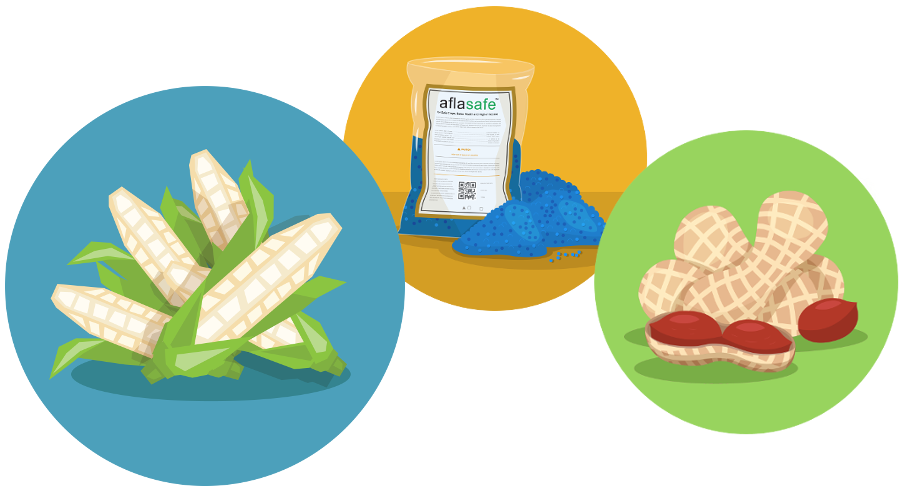Application
 Aflasafe only needs to be applied once a cropping season to be totally effective. Farmers simply spread about 10 kg on each hectare by hand broadcasting – throwing handfuls of Aflasafe onto the fields – 2–3 weeks before crop flowering.
Aflasafe only needs to be applied once a cropping season to be totally effective. Farmers simply spread about 10 kg on each hectare by hand broadcasting – throwing handfuls of Aflasafe onto the fields – 2–3 weeks before crop flowering.- Knowing when the crop is due to flower is the only tricky aspect of using Aflasafe. Farmers may need to be aware of the individual traits of the variety they are growing, or take guidance from their local seed supplier or Aflasafe distributor. Exact timings also depend on location.
- The task of applying Aflasafe is quick and easy: a small plot of one hectare takes four people one hour to treat.
What happens next
- At the time Aflasafe is applied, the population of the Aspergillus fungus that produces aflatoxin is still low.
- Aflasafe is made up of friendly fungal spores of types that never produce aflatoxin, travelling on sorghum grain that acts as both vehicle and food. A few days after application this first wave of spores starts growing on the sorghum and quickly produces lots more spores.
- These spores spread throughout the field. Because they arrive early, and with a food source, they are able to establish themselves well ahead of any other fungal strains residing in the field.
- As the plants begin to produce flowers and later seeds – such as groundnuts or ears of maize – the friendly fungi move in to occupy these too, leaving no room for any other strains to arrive. This means that the vast majority of Aspergillus fungi living on the growing crop are safe Aflasafe strains that do not produce aflatoxin.

- In contrast, if Aflasafe is not used, as crops grow and mature they are occupied by whatever fungi happen to be in the field – likely a mixture of a few benign strains and plenty of dangerous ones, which will contaminate the harvest with aflatoxin.
- Each version of Aflasafe is made up of four friendly strains, all excellent at cutting toxin levels. This variety makes Aflasafe particularly resilient and effective across a wide range of conditions and environments.
- Application of Aflasafe is ideally timed to coincide with rainfall and moist soils that help the spores to grow. Furthermore, even in drought prone areas, Aflasafe has been shown to drastically reduce aflatoxin levels by flourishing after moisture becomes available.
Protection all the way to your plate
- Once the friendly fungi are established on food, they continue to repel any attempts by the toxin-producers to get a toehold – so that means Aflasafe not only does its job out in the field but also keeps working during harvest, transport and storage, all the way to your plate. This prevention of contamination at every stage is a huge advantage of Aflasafe.
 There are two main danger periods for aflatoxin. The first is when the plant is producing the crop. Just like people, plants are more likely to get infection when they are sick and stressed, so if the weather is too hot and dry or if pests attack, the aflatoxin-producing fungi are more likely to move in. The second is later on, when hot and humid conditions can encourage fungi to grow fast. This can happen to a mature harvest out in the field, but is just as likely to be a problem months later while food is being stored. This makes it very important that any product to combat aflatoxin keeps on working, like Aflasafe, long after harvest.
There are two main danger periods for aflatoxin. The first is when the plant is producing the crop. Just like people, plants are more likely to get infection when they are sick and stressed, so if the weather is too hot and dry or if pests attack, the aflatoxin-producing fungi are more likely to move in. The second is later on, when hot and humid conditions can encourage fungi to grow fast. This can happen to a mature harvest out in the field, but is just as likely to be a problem months later while food is being stored. This makes it very important that any product to combat aflatoxin keeps on working, like Aflasafe, long after harvest.- Aflasafe works best in combination with other good practices such as proper drying and storage. However, it also makes a big difference to toxin levels even under poor conditions such as damp storage.
- With repeated Aflasafe applications, the composition of the fungal community in a field begins to shift, with the non-toxin-producers becoming more dominant – and this positive effect spills over into neighbouring areas too. Aflasafe should be applied each cropping cycle to be effective, but there is nonetheless an ongoing benefit across seasons.










